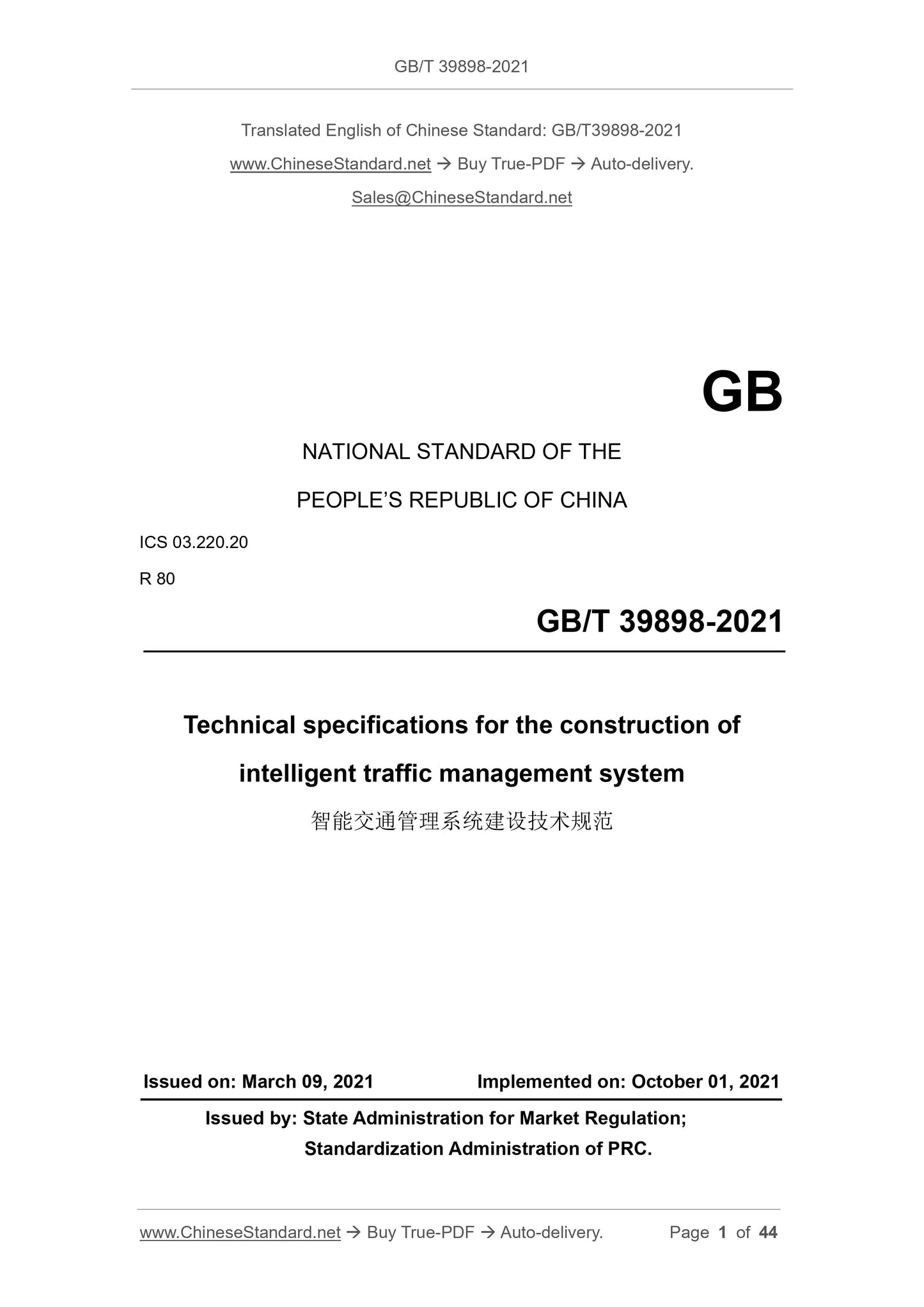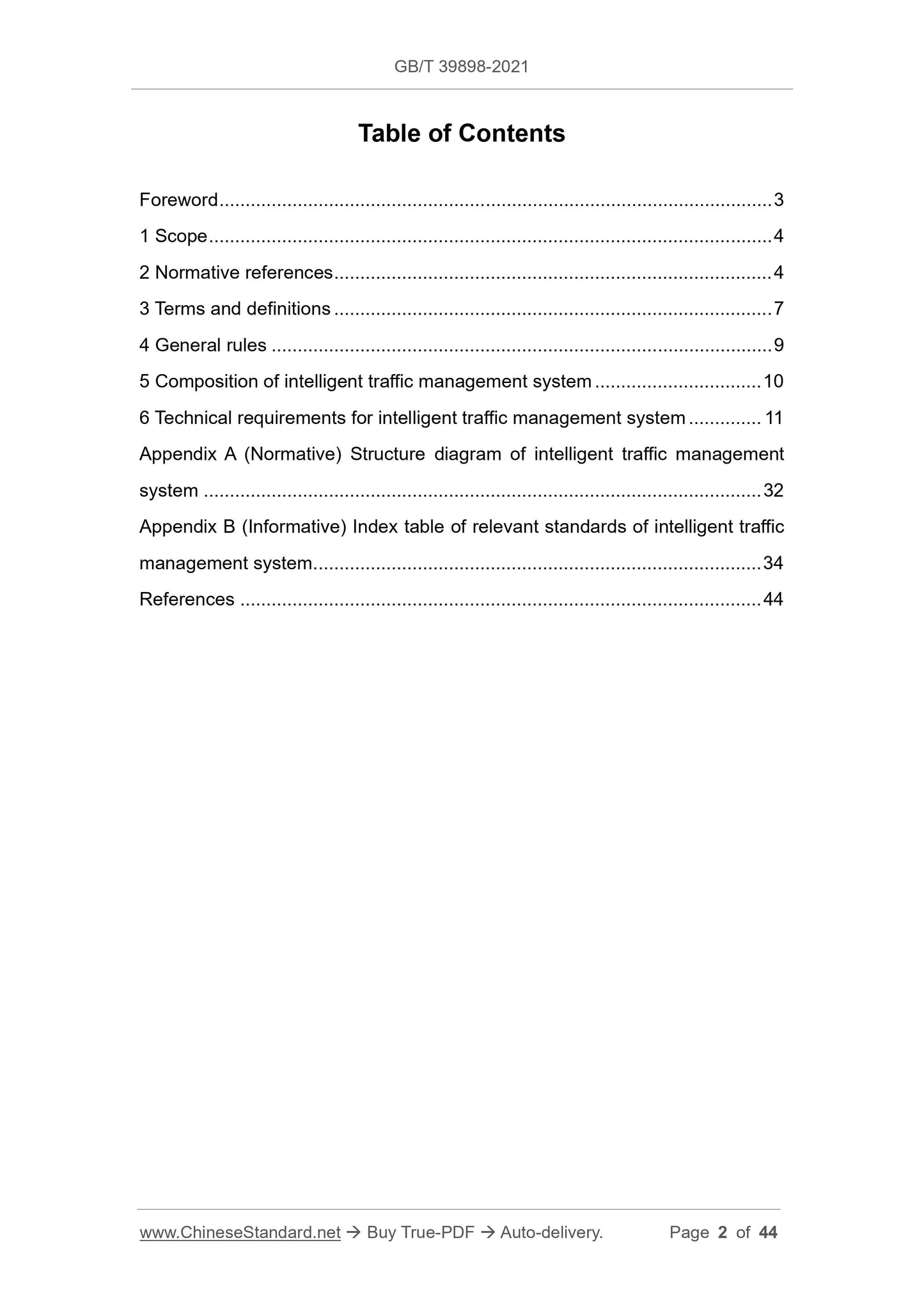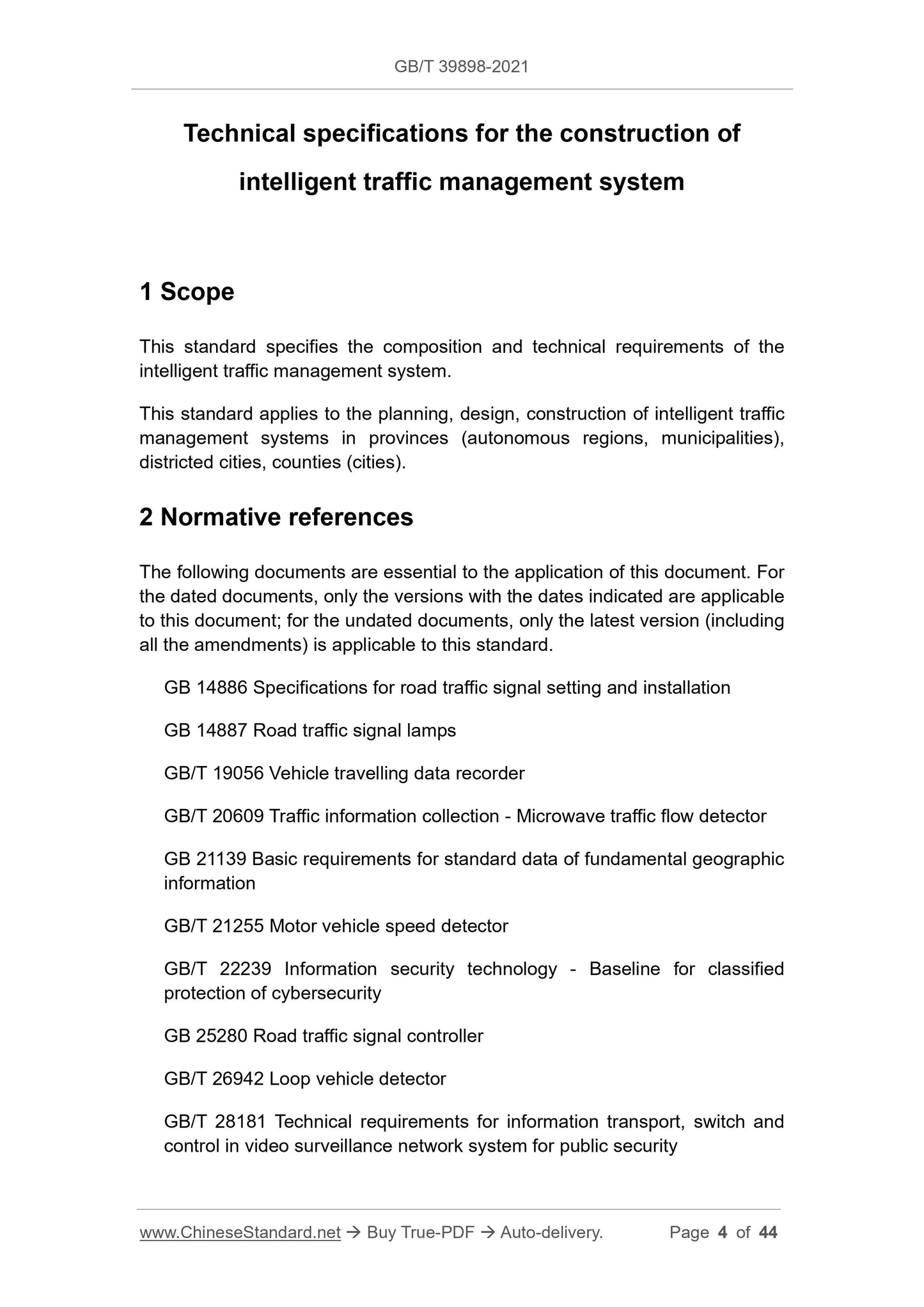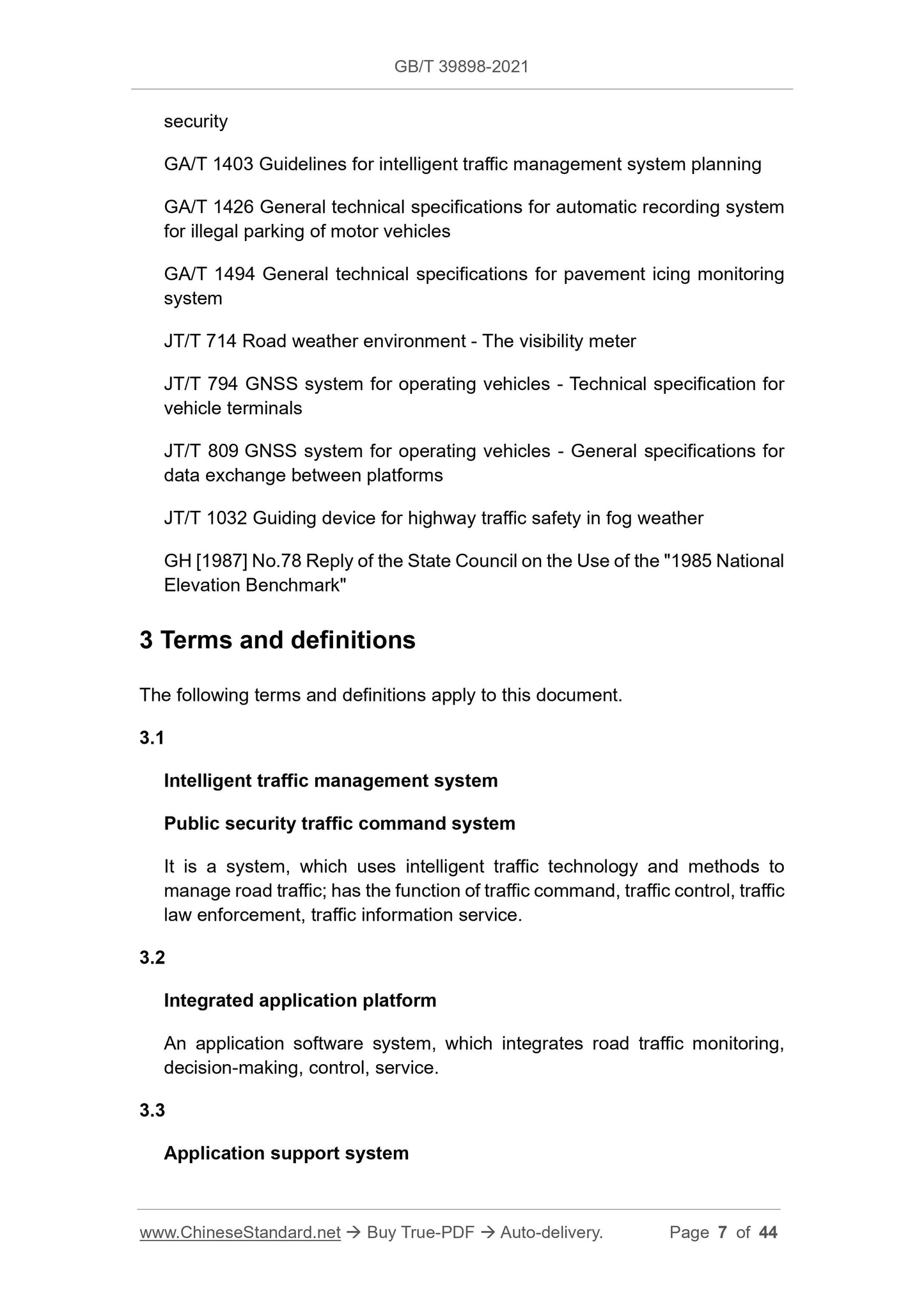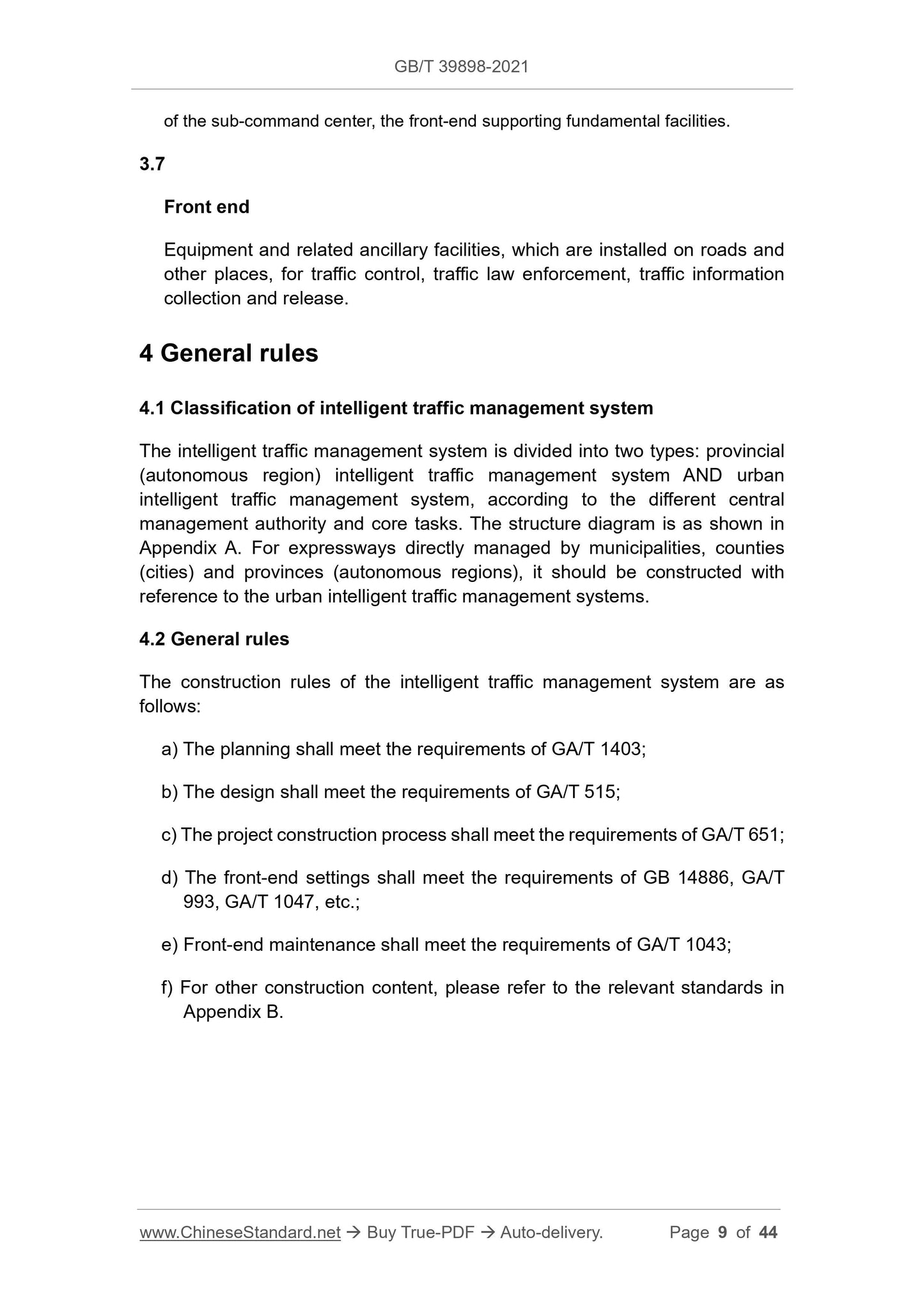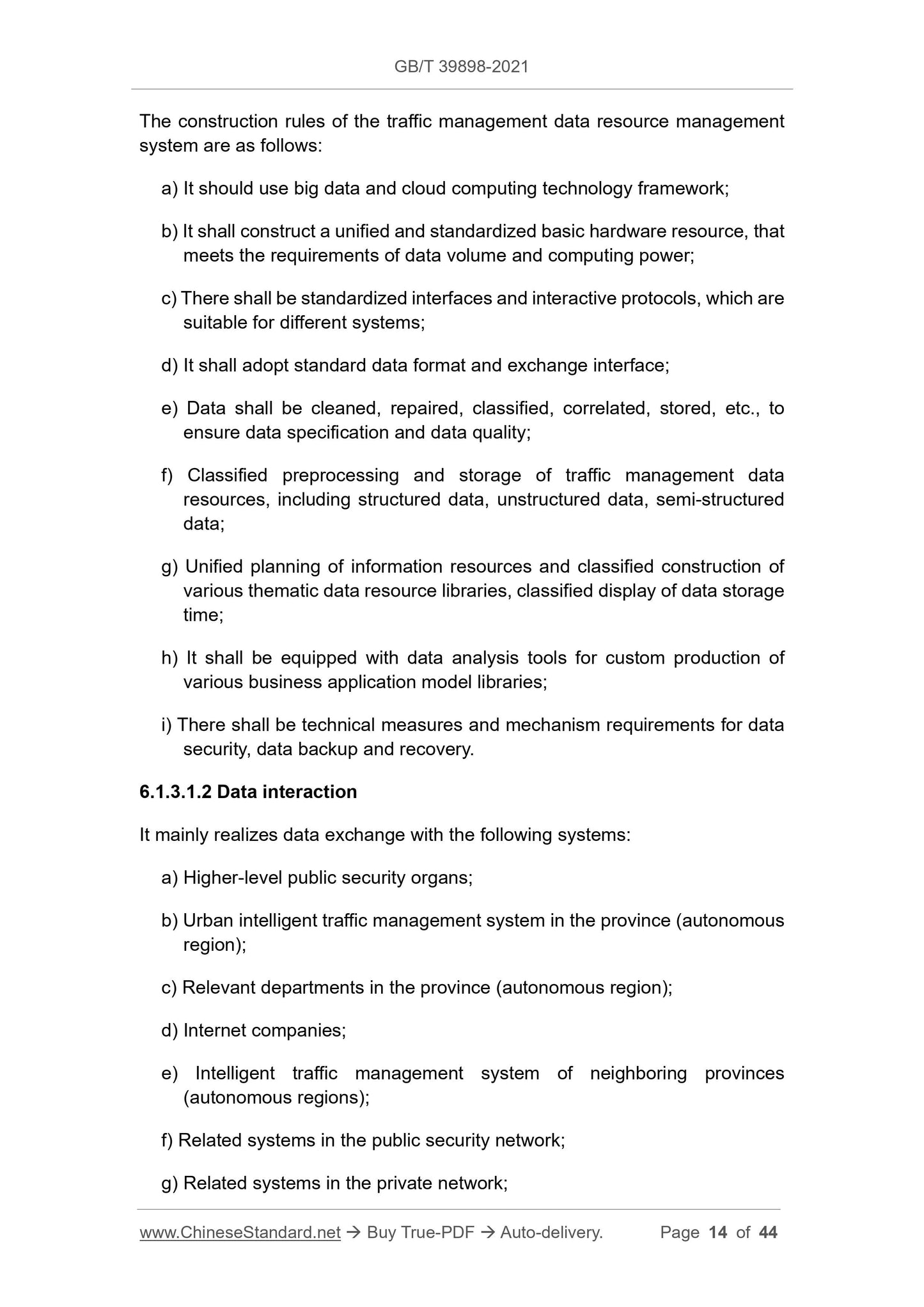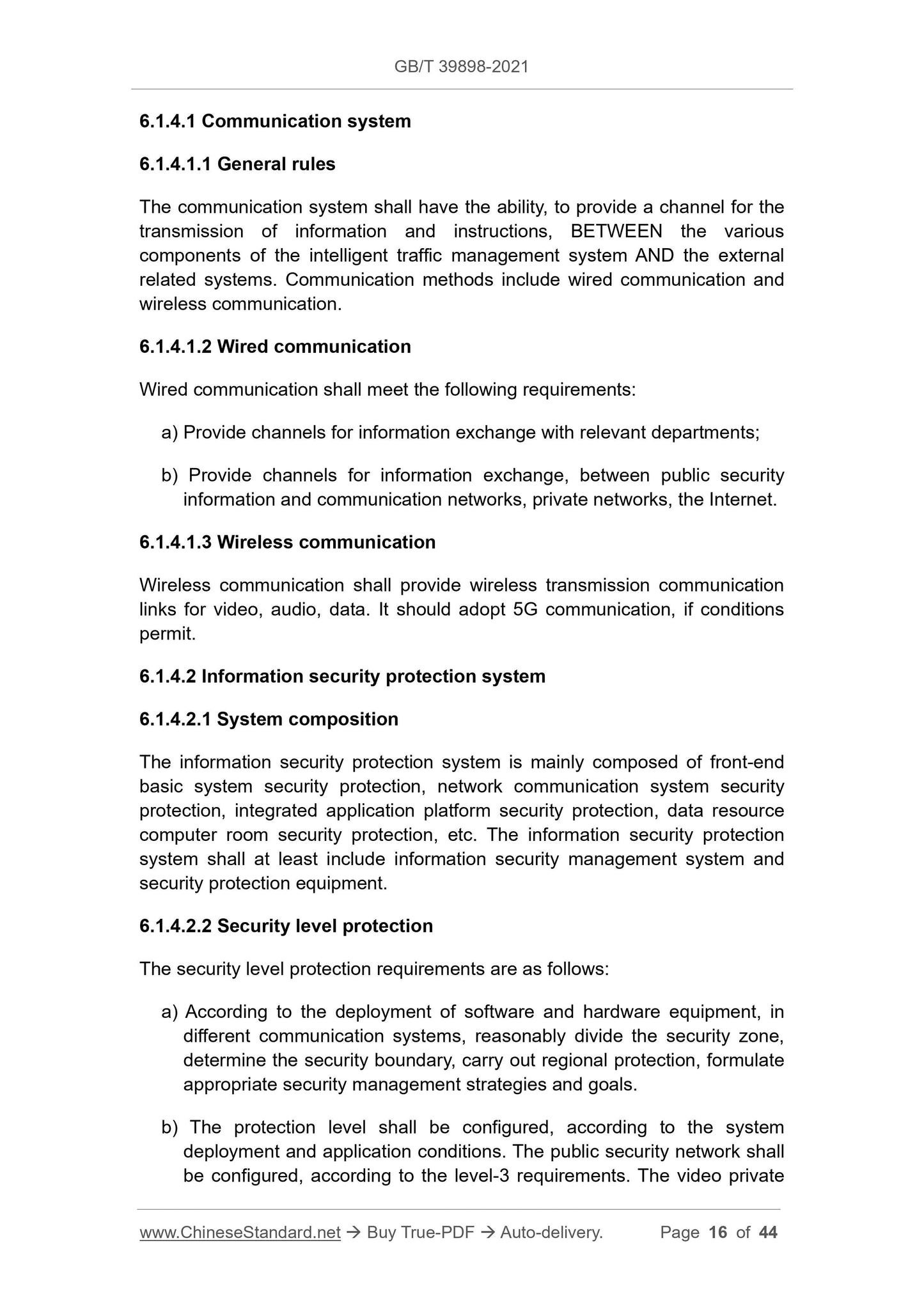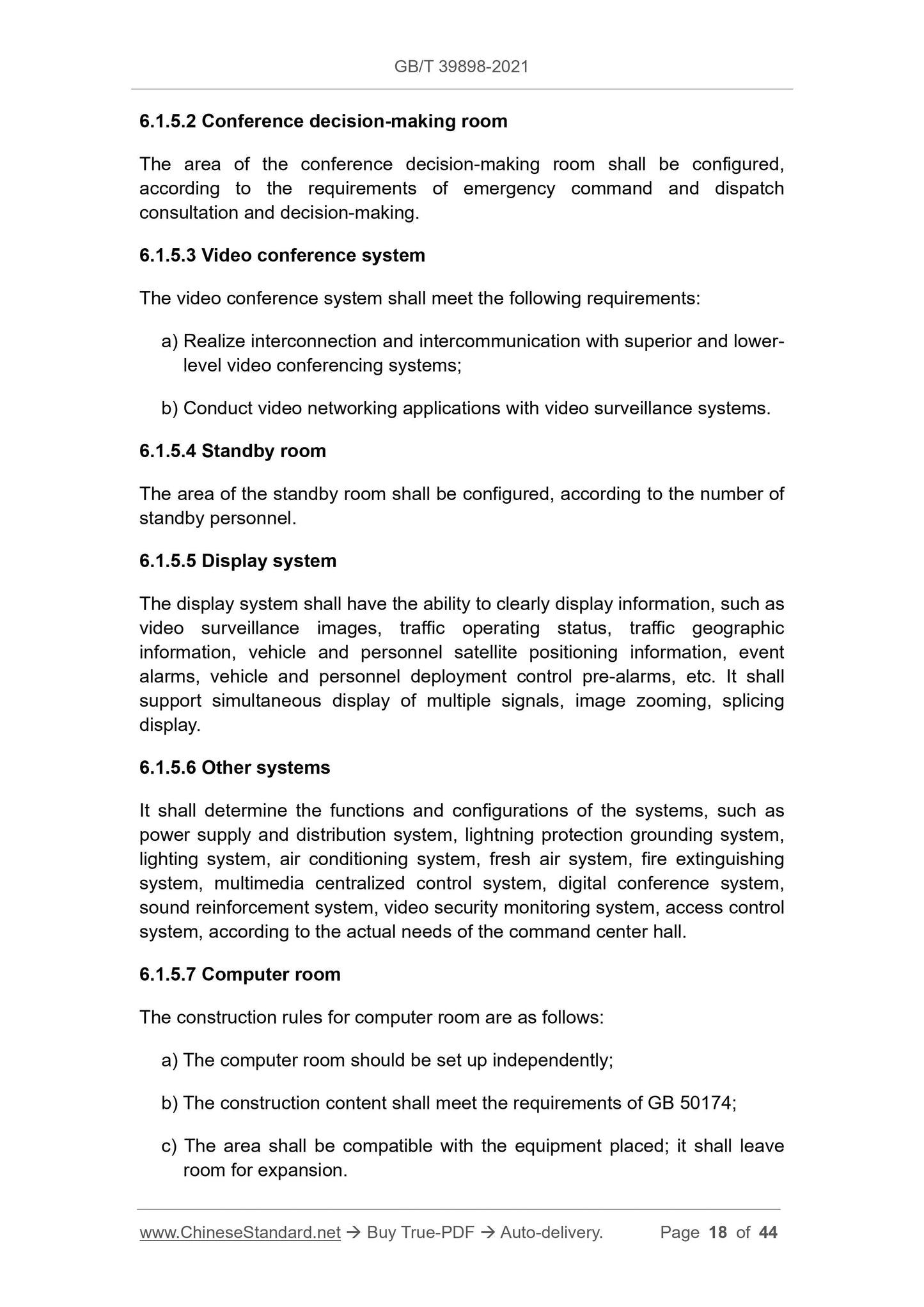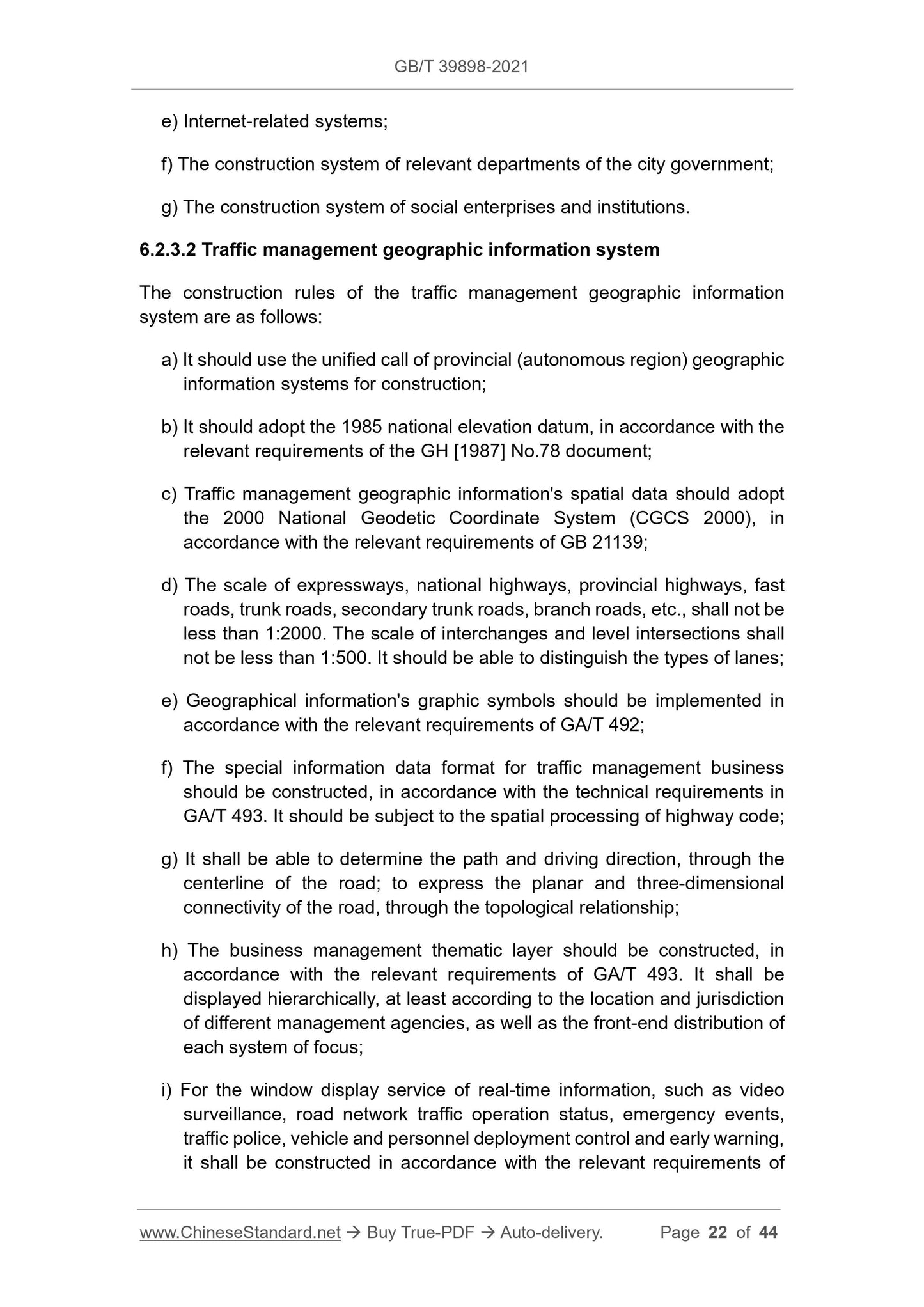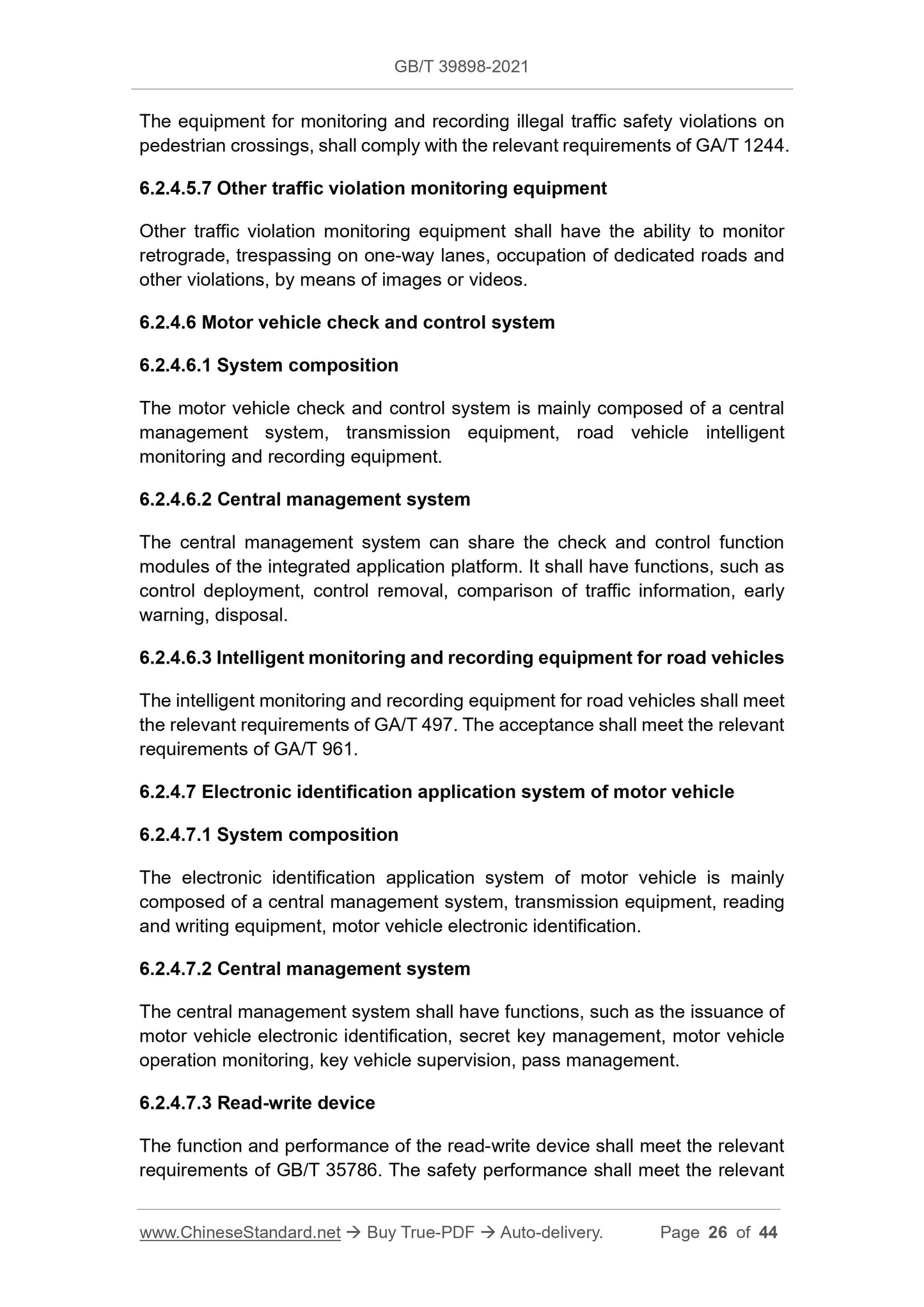1
/
of
10
PayPal, credit cards. Download editable-PDF & invoice in 1 second!
GB/T 39898-2021 English PDF (GBT39898-2021)
GB/T 39898-2021 English PDF (GBT39898-2021)
Regular price
$405.00 USD
Regular price
Sale price
$405.00 USD
Unit price
/
per
Shipping calculated at checkout.
Couldn't load pickup availability
Delivery: 3 seconds. Download true-PDF + Invoice.
Get QUOTATION in 1-minute: Click GB/T 39898-2021
Historical versions: GB/T 39898-2021
Preview True-PDF (Reload/Scroll if blank)
GB/T 39898-2021: Technical specifications for the construction of intelligent traffic management system
GB/T 39898-2021
GB
NATIONAL STANDARD OF THE
PEOPLE’S REPUBLIC OF CHINA
ICS 03.220.20
R 80
Technical specifications for the construction of
intelligent traffic management system
ISSUED ON: MARCH 09, 2021
IMPLEMENTED ON: OCTOBER 01, 2021
Issued by: State Administration for Market Regulation;
Standardization Administration of PRC.
Table of Contents
Foreword ... 3
1 Scope ... 4
2 Normative references ... 4
3 Terms and definitions ... 7
4 General rules ... 9
5 Composition of intelligent traffic management system ... 10
6 Technical requirements for intelligent traffic management system ... 11
Appendix A (Normative) Structure diagram of intelligent traffic management
system ... 32
Appendix B (Informative) Index table of relevant standards of intelligent traffic
management system ... 34
References ... 44
Technical specifications for the construction of
intelligent traffic management system
1 Scope
This standard specifies the composition and technical requirements of the
intelligent traffic management system.
This standard applies to the planning, design, construction of intelligent traffic
management systems in provinces (autonomous regions, municipalities),
districted cities, counties (cities).
2 Normative references
The following documents are essential to the application of this document. For
the dated documents, only the versions with the dates indicated are applicable
to this document; for the undated documents, only the latest version (including
all the amendments) is applicable to this standard.
GB 14886 Specifications for road traffic signal setting and installation
GB 14887 Road traffic signal lamps
GB/T 19056 Vehicle travelling data recorder
GB/T 20609 Traffic information collection - Microwave traffic flow detector
GB 21139 Basic requirements for standard data of fundamental geographic
information
GB/T 21255 Motor vehicle speed detector
GB/T 22239 Information security technology - Baseline for classified
protection of cybersecurity
GB 25280 Road traffic signal controller
GB/T 26942 Loop vehicle detector
GB/T 28181 Technical requirements for information transport, switch and
control in video surveillance network system for public security
security
GA/T 1403 Guidelines for intelligent traffic management system planning
GA/T 1426 General technical specifications for automatic recording system
for illegal parking of motor vehicles
GA/T 1494 General technical specifications for pavement icing monitoring
system
JT/T 714 Road weather environment - The visibility meter
JT/T 794 GNSS system for operating vehicles - Technical specification for
vehicle terminals
JT/T 809 GNSS system for operating vehicles - General specifications for
data exchange between platforms
JT/T 1032 Guiding device for highway traffic safety in fog weather
GH [1987] No.78 Reply of the State Council on the Use of the "1985 National
Elevation Benchmark"
3 Terms and definitions
The following terms and definitions apply to this document.
3.1
Intelligent traffic management system
Public security traffic command system
It is a system, which uses intelligent traffic technology and methods to
manage road traffic; has the function of traffic command, traffic control, traffic
law enforcement, traffic information service.
3.2
Integrated application platform
An application software system, which integrates road traffic monitoring,
decision-making, control, service.
3.3
Application support system
of the sub-command center, the front-end supporting fundamental facilities.
3.7
Front end
Equipment and related ancillary facilities, which are installed on roads and
other places, for traffic control, traffic law enforcement, traffic information
collection and release.
4 General rules
4.1 Classification of intelligent traffic management system
The intelligent traffic management system is divided into two types: provincial
(autonomous region) intelligent traffic management system AND urban
intelligent traffic management system, according to the different central
management authority and core tasks. The structure diagram is as shown in
Appendix A. For expressways directly managed by municipalities, counties
(cities) and provinces (autonomous regions), it should be constructed with
reference to the urban intelligent traffic management systems.
4.2 General rules
The construction rules of the intelligent traffic management system are as
follows:
a) The planning shall meet the requirements of GA/T 1403;
b) The design shall meet the requirements of GA/T 515;
c) The project construction process shall meet the requirements of GA/T 651;
d) The front-end settings shall meet the requirements of GB 14886, GA/T
993, GA/T 1047, etc.;
e) Front-end maintenance shall meet the requirements of GA/T 1043;
f) For other construction content, please refer to the relevant standards in
Appendix B.
The construction rules of the traffic management data resource management
system are as follows:
a) It should use big data and cloud computing technology framework;
b) It shall construct a unified and standardized basic hardware resource, that
meets the requirements of data volume and computing power;
c) There shall be standardized interfaces and interactive protocols, which are
suitable for different systems;
d) It shall adopt standard data format and exchange interface;
e) Data shall be cleaned, repaired, classified, correlated, stored, etc., to
ensure data specification and data quality;
f) Classified preprocessing and storage of traffic management data
resources, including structured data, unstructured data, semi-structured
data;
g) Unified planning of information resources and classified construction of
various thematic data resource libraries, classified display of data storage
time;
h) It shall be equipped with data analysis tools for custom production of
various business application model libraries;
i) There shall be technical measures and mechanism requirements for data
security, data backup and recovery.
6.1.3.1.2 Data interaction
It mainly realizes data exchange with the following systems:
a) Higher-level public security organs;
b) Urban intelligent traffic management system in the province (autonomous
region);
c) Relevant departments in the province (autonomous region);
d) Internet companies;
e) Intelligent traffic management system of neighboring provinces
(autonomous regions);
f) Related systems in the public security network;
g) Related systems in the private network;
6.1.4.1 Communication system
6.1.4.1.1 General rules
The communication system shall have the ability, to provide a channel for the
transmission of information and instructions, BETWEEN the various
components of the intelligent traffic management system AND the external
related systems. Communication methods include wired communication and
wireless communication.
6.1.4.1.2 Wired communication
Wired communication shall meet the following requirements:
a) Provide channels for information exchange with relevant departments;
b) Provide channels for information exchange, between public security
information and communication networks, private networks, the Internet.
6.1.4.1.3 Wireless communication
Wireless communication shall provide wireless transmission communication
links for video, audio, data. It should adopt 5...
Get QUOTATION in 1-minute: Click GB/T 39898-2021
Historical versions: GB/T 39898-2021
Preview True-PDF (Reload/Scroll if blank)
GB/T 39898-2021: Technical specifications for the construction of intelligent traffic management system
GB/T 39898-2021
GB
NATIONAL STANDARD OF THE
PEOPLE’S REPUBLIC OF CHINA
ICS 03.220.20
R 80
Technical specifications for the construction of
intelligent traffic management system
ISSUED ON: MARCH 09, 2021
IMPLEMENTED ON: OCTOBER 01, 2021
Issued by: State Administration for Market Regulation;
Standardization Administration of PRC.
Table of Contents
Foreword ... 3
1 Scope ... 4
2 Normative references ... 4
3 Terms and definitions ... 7
4 General rules ... 9
5 Composition of intelligent traffic management system ... 10
6 Technical requirements for intelligent traffic management system ... 11
Appendix A (Normative) Structure diagram of intelligent traffic management
system ... 32
Appendix B (Informative) Index table of relevant standards of intelligent traffic
management system ... 34
References ... 44
Technical specifications for the construction of
intelligent traffic management system
1 Scope
This standard specifies the composition and technical requirements of the
intelligent traffic management system.
This standard applies to the planning, design, construction of intelligent traffic
management systems in provinces (autonomous regions, municipalities),
districted cities, counties (cities).
2 Normative references
The following documents are essential to the application of this document. For
the dated documents, only the versions with the dates indicated are applicable
to this document; for the undated documents, only the latest version (including
all the amendments) is applicable to this standard.
GB 14886 Specifications for road traffic signal setting and installation
GB 14887 Road traffic signal lamps
GB/T 19056 Vehicle travelling data recorder
GB/T 20609 Traffic information collection - Microwave traffic flow detector
GB 21139 Basic requirements for standard data of fundamental geographic
information
GB/T 21255 Motor vehicle speed detector
GB/T 22239 Information security technology - Baseline for classified
protection of cybersecurity
GB 25280 Road traffic signal controller
GB/T 26942 Loop vehicle detector
GB/T 28181 Technical requirements for information transport, switch and
control in video surveillance network system for public security
security
GA/T 1403 Guidelines for intelligent traffic management system planning
GA/T 1426 General technical specifications for automatic recording system
for illegal parking of motor vehicles
GA/T 1494 General technical specifications for pavement icing monitoring
system
JT/T 714 Road weather environment - The visibility meter
JT/T 794 GNSS system for operating vehicles - Technical specification for
vehicle terminals
JT/T 809 GNSS system for operating vehicles - General specifications for
data exchange between platforms
JT/T 1032 Guiding device for highway traffic safety in fog weather
GH [1987] No.78 Reply of the State Council on the Use of the "1985 National
Elevation Benchmark"
3 Terms and definitions
The following terms and definitions apply to this document.
3.1
Intelligent traffic management system
Public security traffic command system
It is a system, which uses intelligent traffic technology and methods to
manage road traffic; has the function of traffic command, traffic control, traffic
law enforcement, traffic information service.
3.2
Integrated application platform
An application software system, which integrates road traffic monitoring,
decision-making, control, service.
3.3
Application support system
of the sub-command center, the front-end supporting fundamental facilities.
3.7
Front end
Equipment and related ancillary facilities, which are installed on roads and
other places, for traffic control, traffic law enforcement, traffic information
collection and release.
4 General rules
4.1 Classification of intelligent traffic management system
The intelligent traffic management system is divided into two types: provincial
(autonomous region) intelligent traffic management system AND urban
intelligent traffic management system, according to the different central
management authority and core tasks. The structure diagram is as shown in
Appendix A. For expressways directly managed by municipalities, counties
(cities) and provinces (autonomous regions), it should be constructed with
reference to the urban intelligent traffic management systems.
4.2 General rules
The construction rules of the intelligent traffic management system are as
follows:
a) The planning shall meet the requirements of GA/T 1403;
b) The design shall meet the requirements of GA/T 515;
c) The project construction process shall meet the requirements of GA/T 651;
d) The front-end settings shall meet the requirements of GB 14886, GA/T
993, GA/T 1047, etc.;
e) Front-end maintenance shall meet the requirements of GA/T 1043;
f) For other construction content, please refer to the relevant standards in
Appendix B.
The construction rules of the traffic management data resource management
system are as follows:
a) It should use big data and cloud computing technology framework;
b) It shall construct a unified and standardized basic hardware resource, that
meets the requirements of data volume and computing power;
c) There shall be standardized interfaces and interactive protocols, which are
suitable for different systems;
d) It shall adopt standard data format and exchange interface;
e) Data shall be cleaned, repaired, classified, correlated, stored, etc., to
ensure data specification and data quality;
f) Classified preprocessing and storage of traffic management data
resources, including structured data, unstructured data, semi-structured
data;
g) Unified planning of information resources and classified construction of
various thematic data resource libraries, classified display of data storage
time;
h) It shall be equipped with data analysis tools for custom production of
various business application model libraries;
i) There shall be technical measures and mechanism requirements for data
security, data backup and recovery.
6.1.3.1.2 Data interaction
It mainly realizes data exchange with the following systems:
a) Higher-level public security organs;
b) Urban intelligent traffic management system in the province (autonomous
region);
c) Relevant departments in the province (autonomous region);
d) Internet companies;
e) Intelligent traffic management system of neighboring provinces
(autonomous regions);
f) Related systems in the public security network;
g) Related systems in the private network;
6.1.4.1 Communication system
6.1.4.1.1 General rules
The communication system shall have the ability, to provide a channel for the
transmission of information and instructions, BETWEEN the various
components of the intelligent traffic management system AND the external
related systems. Communication methods include wired communication and
wireless communication.
6.1.4.1.2 Wired communication
Wired communication shall meet the following requirements:
a) Provide channels for information exchange with relevant departments;
b) Provide channels for information exchange, between public security
information and communication networks, private networks, the Internet.
6.1.4.1.3 Wireless communication
Wireless communication shall provide wireless transmission communication
links for video, audio, data. It should adopt 5...
Share
